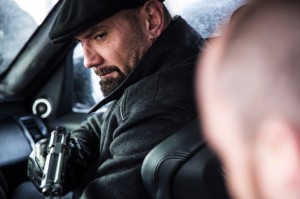Directed by Sam Mendes | Written by John Logan, Neil Purvis, Robert Wade, Jez Butterworth, from a story by Logan, Purvis and Wade, based on the Ian Fleming character | 148 min
“Bond is back… and this time, it’s personal!” This could have been the cheekily lame tagline for each of the four Daniel Craig James Bond films, starting with Casino Royale in 2006. That was an origin story of sorts, and it handily explained some of the British secret agent’s psychological underpinnings, including his problems with commitment. It was the best of the bunch (so far) for offering a fresh slate to the character while reinforcing why, at his core, he is his job.
But in every film since—including Quantum of Solace, Skyfall, and now Spectre, they’ve doubled down on some personal connection in Bond’s past, and each time it hasn’t really worked. For decades the superspy has been embraced universally at least in part because he’s a man of mystery, his beginnings suggested but unknown, which allows audiences to read into him. It’s called mystique, an increasingly elusive quality in our over-sharing era.
Bond’s most defining and appealing characteristic is his devotion to Queen and Country, above all else. It explains and even excuses his ruthlessness. Maybe that’s old hat to some, but needing to connect some plot twist or some enemy to Bond’s private life (such as it is) frequently feels trite, even as it provides a measure of psychological foundation.
That might be my biggest complaint about the Craig Bonds, a series I’ve for the most part really enjoyed. They’ve certainly proved more memorable than the interchangeable Brosnan films. I’ll get into the parts of Spectre I liked (and a few more things I didn’t) in a moment, but be warned: I’m tossing aside any effort at concision, and will be going deep into spoilers. Maybe go see the picture, then come back for the rest of this.
We first happen on Bond in Mexico City, with a bravura tracking shot from within a Day Of The Dead carnival, into an elevator in the Gran Hotel Cuidad and onto the roof of the building. If it’s done with a drone it’s an awfully small and well-piloted one, but I suspect there’s a lot of digital knitting and green screen going on. That leads to a chase through the streets and into a helicopter over the immense Zocalo square — this might be the most impressive pre-credit sequence in the 50+ years of this franchise.
Turns out Bond is there on a personal mission — cued by a posthumous message from M (Judi Dench) —and it puts 007 in hot water with the current M (Ralph Fiennes), who’s under pressure from M’s counterpart at MI:5, Max, also known as C (Sherlock’s Andrew Scott, whose presence here is a bit of a reminder that Spectre could use a lot more of the cleverness baked into that other gig of his). The British government has decided to merge MI:5 and MI:6, and conclude the Double-Oh program in favour of investing in communications surveillance. Why have a man in the field when they can collect all the information they need with a laptop?
This changing, Snowden-esque motif is a rich one to explore, but the film only pays lip service to the idea. Later on, when we discover the connections between C and our real villain, their plan is never fully explained. We sort of have to take it on faith they’re the bad guys.
Speaking of taking things on faith, why M chose to save this key mission for Bond until after her death is never made clear. But, it must be said, Bond movies have never hinged too heavily on elucidating the plot. So long as 007 seems to know what’s going on, we should trust it all to come clear later. The pleasure is in the process.
And there is plenty of to enjoy in that. Mendes, freed up by a larger budget and more international locations due to Skyfall‘s success, and having DP Hoyte Van Hoytema (Interstellar, Her) on board, has made maybe the most beautiful Bond movie ever. The first act — moving from Mexico to London and then to Rome — has an operatic gorgeousness to it, in the lighting, wardrobe, and the score.
We also visit with Q (Ben Whishaw), who provides Bond with a brand new Aston Martin loaded with lethal additions. Not only is the car sexy as hell, its a tacit acknowledgment of why we’ve loved these movies in the past — a playfulness and a sense of scale embraced in movies like The Spy Who Loved Me. (Funny that Bond also gets a watch that goes boom, since Q said in Skyfall about an exploding pen, “we’re not really into that anymore.”)
But then Mendes shoots one of the dullest car chases in recent action movie history. Just take a look at any of the past three Fast & Furiouses, this summer’s Mission: Impossible — Rogue Nation, or even the opening of Quantum to see far more interesting automotive mayhem. Mendes biggest mistake is staging its conclusion largely off-camera, making Bond look like he’s stepped into an ad for high-end chocolates.
Worse, we have a terrific couple of scenes with the legendary Monica Bellucci, only to have her vanish from the movie entirely. What a waste. I suppose the fact she doesn’t die is some kind of structural improvement, given the fate of many of the female characters Bond woos in the early parts of these movies.
The more substantial female lead is Léa Seydoux’s Madeleine Swann, who has a terrific, smoky look, but she and Craig have no chemistry to speak of — a scene on a train mirroring the introduction of Vesper Lynd in Casino Royale has none of the former film’s sexy frisson. Bond’s so-called obligation to her feels like thin motivation, which would have been fine if it’s revealed he was doing it to get to the organization behind all of it, but apparently he felt he actually owed some kind of protection to the daughter of one of his worst enemies.
The callbacks to tradition in the series are fun. I liked that a physically impressive though largely silent henchperson is on the scene, Dave Bautista’s Mr Hinx — whose name is never actually spoken. And the mountaintop spa and plane/car chase down the side of the hill is a thrilling throwback to On Her Majesty’s Secret Service.
When we finally get a showdown between Bond and the Big Bad (Christoph Waltz at his most anodyne), it’s a fizzle. Waltz more whiny than threatening, the desert location doesn’t impress especially, and Bond and Swann escape far too easily.
The need to explain/obscure our villain’s identity — Bloefeld after all, white cat included — is a total Cumberbatch As Khan trick, and just as lame. Casual Bond fans won’t care, and the hardcore can see it coming a mile off. What was the point? And Bond’s shoe-horned personal connection to the villain is entirely unnecessary. It makes Bloefeld’s motivation less a grand, megalomaniacal, world-conquering thing and more a low filial spite, which cheapens it.
For the first time with this series, part what we’re watching feels like fan fiction. That’s a real disappointment, given the much-anticipated return of the most hissable organization in Bond history — Spectre of the title — a big part of the Connery Bonds.
The screenwriters — including the immensely talented John Logan — are happy to play connect-the-dots with the familiar in the franchise without bringing much that feels genuinely new. There are a few more gags this time around, which is the right way to go, but I wouldn’t call it actual wit. It’s a tricky balance, I’ll acknowledge, to be both true to the mythos and advance them. Spectre is a bigger Bond in many ways, and some of that is undoubtably entertaining, but I wish it felt more essential.
This is especially true in the last act, concluding with a bomb, a boat, and yet another helicopter. There’s something about having Bond face representations of the dead in a dungeon that I appreciate — it reminds me of something out of the British spy series The Avengers, a thematic peer to Bond from the 1960s. And final sequence on Westminster Bridge, where he chooses not to employ his license to kill, was probably the right decision. But, by this point, everything feels a little slack.
Having, once again, reestablished Bond and his raison d’etre at the end of Skyfall, what are we supposed to take from his apparent happiness, driving off into the sunrise at Spectre‘s end? It feels sentimental and counter-intuitive. It’s an inalterable truth about his character: He’s only happy when he’s working OHMSS.
This is an ungrateful thought, but if they have Mr Hinx show up during the pre-credit sequence of the next film for some bloody revenge, much will be forgiven.











